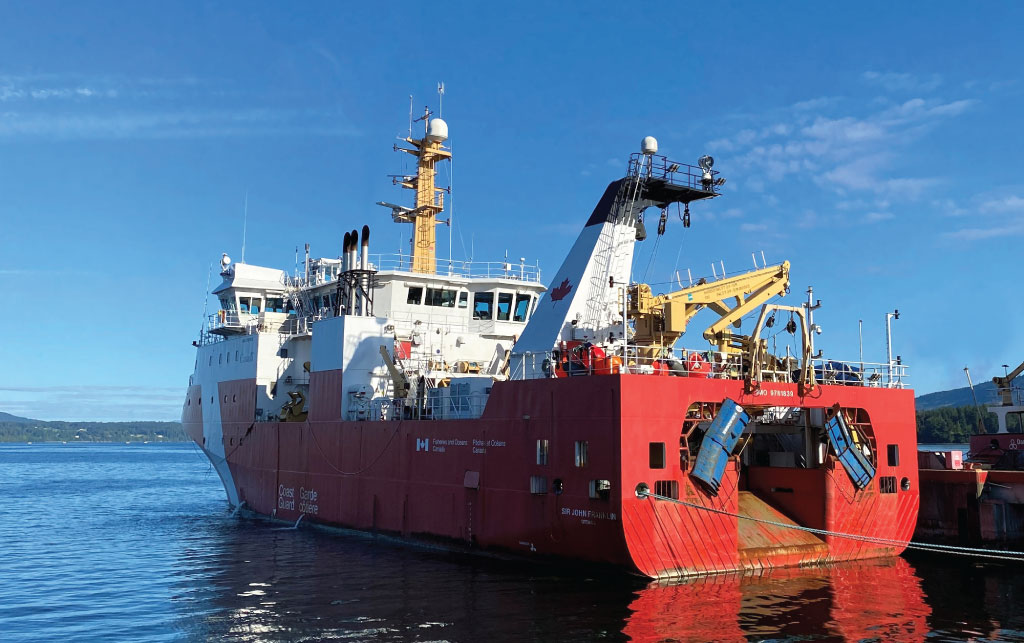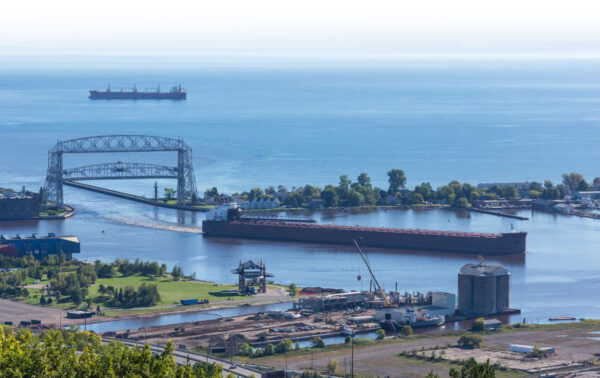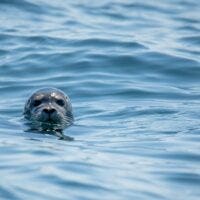Come aboard a Canadian Coast Guard research vessel for a day in the life at sea, collecting data to reduce underwater noise and protect marine mammals.
|
Getting your Trinity Audio player ready...
|
Climb aboard the CCGS Sir John Franklin for a 24-hour research mission in the Pacific Ocean.
During summer 2023, two Clear Seas’ staff members were given the opportunity to go aboard the Canadian Coast Guard Ship (CCGS) Sir John Franklin on a research mission with the MELO Project. Chanessa Perry, an intern with Clear Seas’ Indigenous Internship Program, and Tessa Coulthard, one of Clear Seas’ research associates, learned what it is like to work on a Canadian Coast Guard research vessel, and witnessed scientific research in action while sailing through Boundary Pass in the Pacific Ocean. This journal entry will bring you along on Chanessa and Tessa’s adventure on the CCGS Sir John Franklin.
0800: We arrive at the Institute of Ocean Sciences, eager to board the CCGS Sir John Franklin, one of the newer research vessels in the Canadian Coast Guard fleet.
The Institute of Ocean Sciences (IOS) is located on the Saanich Peninsula, on Vancouver Island, just a ferry ride away from Vancouver. This internationally recognized facility supports Fisheries and Oceans Canada’s (DFO) research on the coastal waters of British Columbia, the Northeastern Pacific Ocean, navigable fresh waters of the west coast east to the Alberta border, and the Western Canadian Arctic. We are greeted by a friendly employee who shows us how to get down to the docks and the research vessel. The docks are busy with Canadian Coast Guard employees getting multiple vessels prepared for their voyages – even at 8AM, there is a lot going on at IOS. We are here to conduct research with the MELO Project team from the University of British Columbia (UBC). The rest of the research team from UBC (11 people in total!) arrives shortly afterwards and meets us down at the dock right in front of the CCGS Sir John Franklin. Coming from Vancouver, they took the earliest possible ferry over to IOS that morning and brought with them all the equipment they needed for the research campaign. We load up the gear and make our way up the metal ramps and stairs to board the vessel. The research trip we have been looking forward to all summer is finally here.

0830: We gather on the bridge to meet the captain of the vessel, Capt. Jeff Olsson, who welcomes us onboard. We start with a quick recap of the research program plan, then the crew and research team establish a timeline for the day.
The MELO Project team needs this time onboard the research vessel to gather acoustic data by transiting overtop an array of hydrophones located underwater in Boundary Pass. As the vessel passes over the hydrophones, the level of noise is recorded by the hydrophones and sent to a computer to be processed.
Since the noise a vessel makes changes based on certain factors (such as speed or mechanical configurations), the team plans to make 13 passes over the same hydrophone array at varying speeds. The acoustic data from the hydrophones will be used by the MELO Project team as real-world parameters to a computational model.
The MELO team are working on building a computational model that can be used to predict the noise signature of vessels based on the operating parameters. They will use the data to validate their current model and determine if they can successfully predict the noise signature of the CCGS Sir John Franklin, based on their understanding of the ship, the speed, the oceanographic conditions, and other factors. In addition to collecting acoustic data through hydrophones, the research team also plans to gather oceanographic data and take some measurements of vibrations on some of the machinery in the engine room. More on that later!
For most of the research team, it is their first time on a larger vessel that is not a passenger vessel, like a ferry or cruise ship. The CCGS Sir John Franklin, built in 2015, is a newer vessel in the Coast Guard fleet. As a research vessel, it is mainly used by DFO scientists for fish surveys along the coast. We are impressed with the size of the vessel, and how well equipped it is for so many different types of research. Almost like a maze, with so many corridors and small connecting rooms, it is easy to get lost exploring the different decks, but there is always a crew member around to point you in the right direction.
At 9AM, the vessel leaves the dock and heads into Boundary Pass – we have set sail!
1000: After settling into our cabins, we join Capt. Jeff and Lily, one of the crew members, for a safety demonstration on the bridge. Lily gives a routine explanation on the safety procedures aboard the vessel. She highlights the importance of watching our steps, closing doors properly, and asking a crew member for help if we do not know what to do in any situation. Lily also wants to ensure that everyone is respectful of the crew that may be sleeping during the day, since they work long hours and need to be well-rested to perform their duties. We learn a lot about how the ship runs, the jobs of the crew members and how to stay safe on the vessel. We head back to our bunks to get sorted before lunchtime and prepare for a long day of research on the water. There are five double cabins with bunk beds set aside for the research team, and one single cabin for the head scientist. Although a little tight, the cabins are very comfortable, and the bunk beds make it feel a bit like summer camp. We look forward to being rocked to sleep by the waves that evening.

1100: It’s lunchtime! We all gather in the “mess” (nautical for “dining room”) to fuel up for a big day. One of the highlights of our time on the research vessel is the amazing food prepared onboard – we enjoy all the meals and love getting to know the crew that works so hard to feed everyone every single meal, for weeks at a time. During lunch, the CCGS Sir John Franklin begins making the first trip over the hydrophone array in Boundary Pass.
1230: The research program activities are kicked off after lunch with the first cast of the CTD to gather oceanographic data from the study area just off Saturna Island, one of the southern Gulf Islands in the Salish Sea. A CTD, which stands for conductivity temperature and depth, is an instrument that descends through the water column to gather information on salinity and temperature at different depths. This information will be used in the MELO Project’s computational model to account for how water properties can influence the transmission of sound. You can cast a CTD by hooking it up to a winch or it can be thrown overboard by hand. In this case, a few deck crew members use a winch to lower the CTD overboard and then steadily drop it at a rate of one metre per second to a depth of 165 m. Taryn Scarff, a master’s student in the Marine Mammal Research Unit at UBC, is the lead researcher managing the deployment of the CTD with the assistance of Indu Kant Deo, a PhD student in Mechanical Engineering at UBC. Over the course of our time at sea, the CTD will be cast another three times in different locations to gather more oceanographic data in the study area.

Although Taryn is not an official member of the MELO Project team, her expertise in operating CTDs and processing oceanographic data was so valuable during the research program activities! We caught up with Taryn between CTD deployments to learn a bit more about her research at UBC:
I study transient killer whales in the Salish Sea, with a specific focus on the factors that influence their distribution. My research will help inform conservation efforts in the region and will hopefully contribute to a better understanding of the importance of the Salish Sea as a home for both southern resident and transient killer whales.
Taryn Scarff
Not only is Taryn great with a CTD, but she also has a sharp eye for spotting marine mammals! When not working with the crew to collect oceanographic data, you could find her on the top of the vessel with binoculars, scanning for whales on the horizon.
1330: After the excitement of the first cast of the CTD, we get a full tour of the vessel with Capt. Jeff Olsson. He has been working with the Canadian Coast Guard in varying capacities for more than twenty years. Capt. Jeff has a busy job – as captain, his job is to make sure the research activities are running successfully by managing the crew, directing the course of the vessel, and ensuring the safety of everyone onboard. Although the CCGS Sir John Franklin is a research vessel, in the event of an emergency, any Coast Guard vessel could be asked to respond to a search and rescue event, so the captain must be comfortable making decisions and changing plans at the last moment.
As Capt. Jeff shows us around the vessel and explains how everything works onboard, we can tell that he is passionate about his job. One of his favourite parts about working with the Coast Guard is the opportunity to see some of the most remote and beautiful parts of the coast. From sandy beaches on Calvert Island to hot springs on Haida Gwaii, life at sea has offered him the chance to go places very few people are able to visit and meet the amazing people who call these areas home. He sees the value in working on a research vessel and appreciates being able to contribute to a better understanding of the ocean for conservation purposes.
Becoming a captain with the Canadian Coast Guard takes time and dedication. Attending the Canadian Coast Guard college is one way to begin a career with the Coast Guard. Afterwards, time at sea onboard vessels and the successful completion of different certifications are required to work your way up in the organization. For more information on working with the Canadian Coast Guard, check out their website here.

1500: During our tour of the vessel, we stop to check out the engine room. Capt. Jeff introduces us to the Senior Engineer, Dave Steele, who has been working as an engineer on vessels for the last 23 years. Dave makes sure we are supplied with the appropriate personal protective equipment, including ear coverings, and warns us not to lean on anything – we don’t want grease on our clothing. Engine rooms are loud. Located on the lower deck of the vessel, the engine room holds all of the operational machinery that keeps the vessel running. We see some of the UBC students from the MELO Project team taking measurements of the vibrations emitted from the machinery. The data they are gathering in the engine room will be inputted into the model to understand how noise is propagated from the engine room of the vessel.
1600: We find a perfect spot outside on a narrow platform to work, write and soak up the sunshine. There is a beautiful view of the ocean, and we can see some of the crew members hard at work on the deck below. After a nice break in the sun, we walk around to take photos of the crew and ship. Talking with a few friendly crew members, we learn they are almost finished with their 28-day shift at sea and will soon be on their time off for 28 days. They are all looking forward to getting back on land to see their friends and family (or back on the water to do a little fishing!).
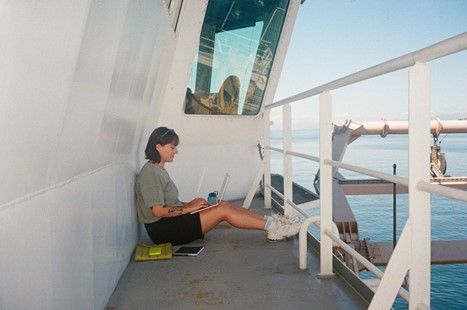
1730: At dinner time, we head back down to the mess where we are served a delicious meal of chickpea curry and chat with each other about the day and the day’s research activities. Afterwards, we head back up to the bridge to play cards with a couple of the MELO project team members and relax before sunset.
2030: By sunset, the final passes over the hydrophones in Boundary Pass are complete. It has been a successful day of gathering acoustic data, and the research team is satisfied with the results. Before we call it a night, we ask for permission to go on the highest lookout on the ship, called “monkey island”. We climb up there with binoculars in hand, in hopes of catching a glimpse of some marine life and taking in the breathtaking view of a sunset on the ocean. The sky is clear and the water is calm as the vessel anchors in a harbour off of Pender Island for the night.
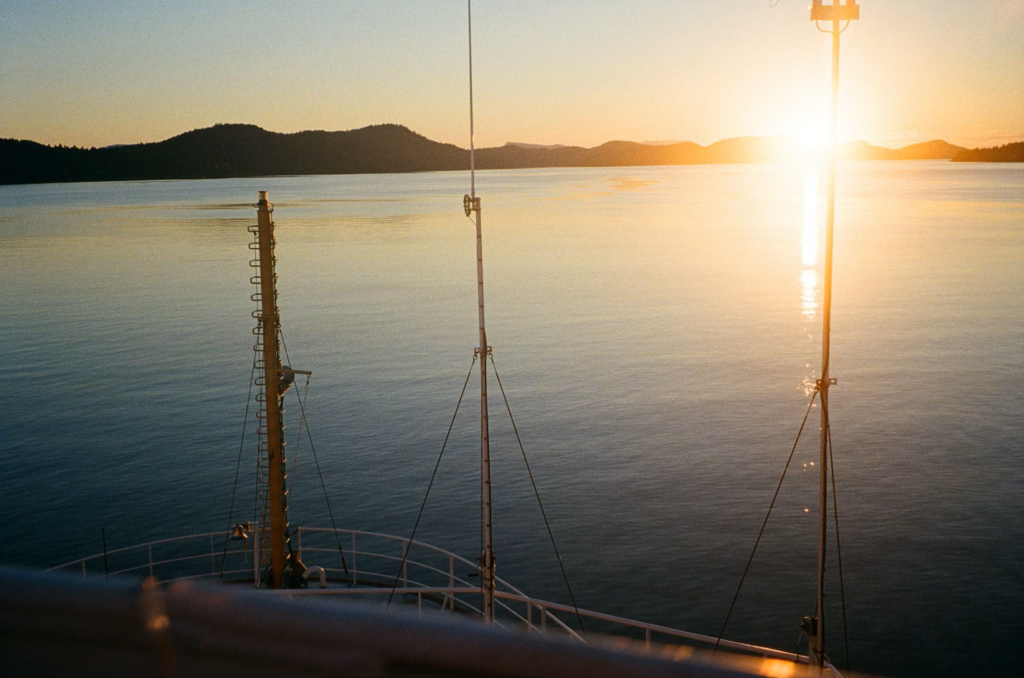
2100: After sunset, we retire to our cabin to get ready for bed and rest up for another day of research activities tomorrow. The crew onboard the CCGS Sir John Franklin is so welcoming, and we have loved getting to learn about their lives at sea! Although our research program is limited to one night of “sea time”, some science research trips on this vessel span multiple weeks. If you ask us, sleeping in a cozy bunk bed for a couple of weeks while traveling around the coastal waters of British Columbia sounds like a pretty good way to spend the summer.
We extend our gratitude to the Canadian Coast Guard for hosting Clear Seas and UBC’s MELO Project team onboard the CCGS Sir John Franklin and making our research activities possible. Thank you!
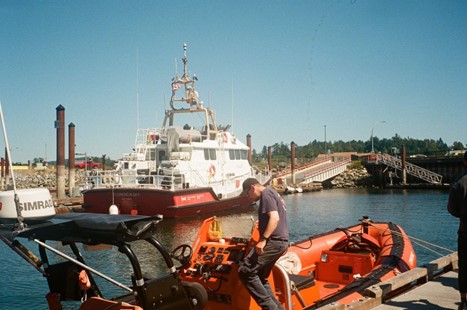
This article was cowritten by Chanessa Perry, intern with Clear Seas’ Indigenous Internship Program and Tessa Coulthard, research associate with Clear Seas.
